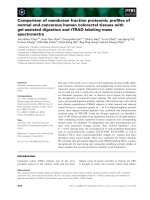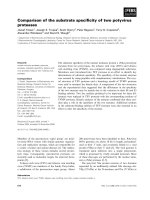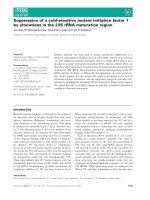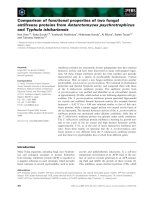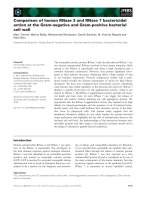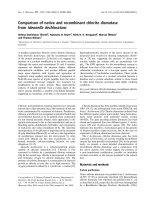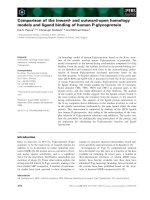Báo cáo khoa học: " Comparison of three cold storage methods for Norway spruce (Picea abies Karst) bare root seedlings: consequences on metabolic activity of ectomycorrhizae assessed by radiorespirometry" pdf
Bạn đang xem bản rút gọn của tài liệu. Xem và tải ngay bản đầy đủ của tài liệu tại đây (650.36 KB, 7 trang )
Original
article
Comparison
of
three
cold
storage
methods
for
Norway
spruce
(Picea
abies
Karst)
bare
root
seedlings:
consequences
on
metabolic
activity
of
ectomycorrhizae
assessed
by
radiorespirometry
K
Al
Abras
F
Le
Tacon,
F
Lapeyrie
INRA,
Centre
de
Recherches
Forestières
de
Nancy,
Champenoux,
54280
Seichamps,
France
(Received
3
December
1990;
accepted
7
June
1991)
Summary —
Bare
root
forest
tree
seedlings
are
very
sensitive
to
environmental
factors,
including
cold
storage.
The
metabolic
activity
of
2
types
of
ectomycorrhizae
of
Norway
spruce
seedlings,
after
cold
storage
for
2
weeks
under
3
experimental
conditions,
was
compared
using
radiorespirometry.
The
mycorrhizal
type
B00
had
a
lower
metabolic
activity
before
treatment
and,
was
more
resistant
to
cold
storage
than
the
A12
type.
These
observations
were
in
general
agreement
with
previously
pub-
lished
field
experiments,
where
B00
became
dominant
and
A12
was
suppressed
after
cold
storage
and
transplanting.
Ectomycorrhizal
fungi
could
be
selected
according
to
these
criteria
for
controlled
nursery
inocculation.
Storage
at
4
°C
in
polyethylene
bags
did
not
affect
the
metabolic
activity
of
ec-
tomycorrhizae,
unlike
other
storage
conditions.
seedlings
/
cold
storage
/
ectomycorrhizae
/
Norway
spruce
/
radiorespirometry
/
nursery
Résumé —
Comparaison
de
trois
méthodes
de
conservation
au
froid
de
plants
à
racines
nues
d’épicéa
commun
(Picea
abies
Karst).
Conséquences
sur
l’activité
métabolique
des
ec-
tomycorhizes.
Les
plants
forestiers
à
racines
nues
sont
particulièrement
sensibles
à
tous
les
fac-
teurs
du
milieu,
y
compris
durant
les
périodes
de
stockage
à
basse
température.
Les
mycorhizes
contrôlant
la
nutrition
minérale
du
plant
in
situ,
les
dommages
qu’elles
subissent
lors
des
opérations
de
stockage
sont
très
certainement
une
des
composantes
de
la
crise
de
transplantation.
L’activité
métabolique
de
2
types
d’ectomycorhizes
associées
à
des
plants
d’épicéa
commun
a
été
comparée
par
radiorespirométrie
après
deux
semaines
de
stockage
au
froid.
Nous
avons
mesuré :
le
dégage-
ment
de
14CO
2
(fig
2)
l’incorporation
(fig 3)
et
l’absorption
de
14
C
(fig
4)
par
des
mycorhizes
excisées
en
présence
de
[1-
14C]
glucose.
Les
plants
ont
été
préalablement
stockés
durant
deux
semaines
soit
à
-4
°C
en
sacs
de
polyéthylène
clos,
soit
à
+4
°C
avec
ou
sans
emballage.
Avant
stockage
les
mycorhizes
de
type
B00
avaient
une
activité
métabolique
plus
faible
que
celles
de
type
A12,
mais
semblent
mieux
préservées
après
stockage.
Ces
résultats
concordent
avec
des
travaux
publiés
an-
térieurement
et
montrant
que
le
type A
12
avait
une
faible
capacité
à
se
maintenir
sur
le
système
ra-
cinaire
des
plants
après
stockage
et
transplantation,
alors
que
le
type
B00
devenait
dominant
dans
les
mêmes
conditions.
L’aptitude
des
champignons
mycorhiziens
à
résister
au
stockage
pourrait
être
un
critère
supplémentaire
de
sélection
des
souches
destinées
à
l’inoculation
contrôlée
des
pépi-
nières.
Parmi
les
techniques
de
stockage
comparées,
seul
un
stockage
à
+4
°C
en
sacs
de
polyé-
thylène
n’affecte
l’activité
métabolique
d’aucun
des
deux
types
de
mycorhizes
étudiés.
plants
/
stockage
au
froid
/
ectomycorhizes
/
Epicéa
commun
/
radiorespirométrie
/
pépinière
*
Correspondence
and
reprints
INTRODUCTION
Bare
root
forest
trees
seedlings
are
quite
sensitive
to
environmental
conditions
from
the
time
they
are
lifted
from
the
nursery
beds
to
the
time
they
are
set
in
the
forest
stand.
The
stress
encountered
by
the
root
system
during
lifting
and
planting
opera-
tions
can
cause
serious
losses
in
survival
(Cossitt,
1961;
Mullin,
1974).
The
storage
period
can
sometimes
be
reduced
to
a
minimum.
However,
when
managing
large
nurseries
or
vast
reforestation
areas,
it
cannot
be
avoided.
The
most
prevalent
technique
remains
storage
in
cold
room,
either
for
several
months
between
winter
lifting
and
spring
planting,
or
for
only
a
few
weeks
after
spring
lifting.
Several
cold
storage
methods
have
been
used
and
compared
in
order
to
re-
duce
plant
damage
(Lanquist
and
Doll,
1960;
Wycoff,
1960;
Harvey,
1961;
Kahler
and
Gilmore,
1961;
Mullin,
1966, 1980,
1983;
Mullin
and
Parker,
1974;
Nelson,
1980;
Cram
and
Lindquist,
1982;
Tisserat
and
Kuntz,
1984;
Venator,
1985).
These
comparative
studies
were
based
on
seed-
lings
survival
after
plantation,
and
do
not
consider
the
physiological
stress
encoun-
tered
during
storage.
Seedling
physiology
has
been
recently
investigated,
especially
as
it
is
affected
by
lifting
date
and
cold
storage
conditions
on
carbohydrate
content,
bud
dormancy,
shoot
apical
mitotic
index,
frost
hardening,
or
dessication
resistance
(Ritchie
et
al,
1985;
Cannell
et al,
1990),
but
ectomycor-
rhizae,
which
control
nutrition
of
trees
in
nurseries
and
after
outplanting,
have
been
overlooked.
In
a
previous
study,
we
have
shown
that
different
ectomycorrhizal
populations
responded
differently
to
storage
stress,
leading
to
regression
or
extension
of
these
populations
on
the
root
system
after
plan-
tation
(Al
Abras
et al,
1988b).
In
this
paper,
we
compare
the
metabolic
activity
of
2
types
of
Norway
spruce
ectomycorrhizae
in
seedlings
subjected
to
cold
storage.
Ra-
diorespirometry
was
used
to
characterize
the
metabolic
activity
of
the
ectomycorrhi-
zae.
MATERIALS
AND
METHODS
Plant
material
Four-year
old
bare
root
seedlings
of
Picea
excel-
sa
(Lam)
Link,
grown
on
a
sandy
soil
in
a
com-
mercial
nursery
(eastern
France),
were
lifted
in
May,
all
at
the
same
date,
and
eventually
trans-
ferred
to
dark
cold
rooms
2
h
later.
Treatments
Four
treatments
were
applied
to
seedlings
(30
plants
per
treatment) :
-
Two
weeks
storage
at
+4
°C
in
closed
polyeth-
ylene bags.
-
Two
weeks
storage
at
+4
°C
and
98
±
5%
hu-
midity
(in
heap
without
bag).
- Two
weeks
storage
at
-4
°C
in
closed
polyethy-
lene
bags.
-
No
storage
(The
control
plants
were
stored
overnight
at
4
°C
before
ectomycorrhizal
sam-
pling).
Ectomycorrhizal
sampling
After
2
weeks
cold
storage
or
a
few
h
after
lift-
ing,
the
plants
were
brought
to
room
tempera-
ture
for
1
h.
The
root
systems
were
washed
carefully
under
tap
water
to
remove
most
of
the
soil
particles.
Ectomycorrhizae
belonging
to
the
dominant
A12
and
B00
types
previously
de-
scribed
(Al
Abras,
1988),
were
sampled.
Four
subsamples
of
each
mycorrhizal
type
per
treat-
ment
were
analysed
separately
using
radio-
respirometry.
A12
mycorrhizae
are
characterized
by
an
abundant
extramatrical
mycelium.
In
cross
sec-
tion
the
mantle
has
2
distinct
layers:
the
outer-
most
prosenchymateous
layer
of
hyphae
bear
clamp
connections
and
the
innermost
layer
has
a
plectenchymatic
structure.
The
well
developed
Hartig
net
extends
to
the
endodermis
(fig
1a,
b).
B00
mycorrhizae
are
characterized
by
a
smooth
external
surface,
a
very
thin
plectenchy-
matic
mantle
lacking
clamp
connections,
and
a
well
developed
Hartig
net
extending
to
the
endo-
dermis
(fig
1c,
d).
Radiorespirometry
The
radiochemical
[1-
14C]
glucose
(50
mCi/
mmol)
was
purchased
from
the
Commissariat
à
l’Energie
Atomique
(Gif
sur
Yvette,
France).
The
antibiotics
aureomycin,
penicillin,
and
streptomy-
cin
were
from
Sigma.
All
others
chemicals
were
of
analytical
grade.
Respiration
was
quantified
using
a
10-ml
continuous
14CO
2
-evolving
and
trapping
reac-
tion
flask
(Al
Abras et
al,
1988a).
About
50
mg
of
fresh
mycorrhizae
were
incubated
in
5
ml
of
distilled
water
containing
10
nmol
of
[1-
14
C]glucose
(0.5
μCi)
at
20
°C.
An
air-flow
of
200
ml/min
was
maintained
and
14CO
2
was
col-
lected
over
90
min.
Antibiotics
were
added
to
the
incubation
solution
at
the
following
concen-
trations
to
prevent
bacterial
activity:
penicillin
12.5
mg/l,
streptomycin
25
mg/l
and
aureomycin
5
mg/l.
Effluent
air
was
passed
directly
into
a
CO
2
-trapping
scintillation
fluid
(Carbomax-
Kontron)
in
10-ml
vials
and
counted.
After
90
min
incubation,
radiolabel
was
also
deter-
mined
in
methanol/water
(70:30,
v:v)
extracts
of
mycorrhizae
(soluble
compounds).
Results
are
presented
as
means
of
4
subsamples
with
confi-
dence
intervals
(P=
0.05)
and
are
expressed
as
picomoles
of
14CO
2
produced,
or
as
picomoles
of
14
C
incorporated
or
absorbed/mg
dry
weight.
RESULTS
Before
storage,
type
B00
mycorrhizas
re-
leased
50%
less
14CO
2
than
the
A12
type
(fig
2).
Storage
at
4
°C
in
closed
polyethy-
lene
bags
for
2
weeks
did
not
modify
the
CO
2
release
by
either
mycorrhizal
type
(fig
2).
By
contrast,
storage
without
a
bag
at
4
°C
and
98%
humidity
reduced
14CO
2
re-
lease
by
50%
in
B00
type
and
by
75%
in
A12
type
(fig
2).
Storage
at
-4
°C
modified
the
CO
2
release
by
the
A12
type
only,
(-50%),
while
the
CO
2
release
by
B00
type
was
not
significantly
reduced.
Comparing
the
14
C
incorporation,
the
same
conclusions
can
be
drawn,
even
more
obviously
as
both
mycorrhizal
types
incorporated
the
same
level
of
14
C
before
storage
(fig
3).
Storage
at
4
°C
in
polyethy-
lene
bags
had
no
effect
on
14
C
incorpora-
tion
by
either
mycorrhizal
type
(fig
3).
How-
ever,
storage
outside
polyethylene
bags
greatly
reduced
incorporation,
by
85%
in
A12
type
and
50%
in
B00
type
(fig
3).
Stor-
age
at
-4
°C
reduced
14
C
incorporation
in
A12
type
only
(-30%)
(fig
3).
The
14
C
absorption,
last
parameter
of
metabolic
activity,
integrates
14CO
2
pro-
duction
and
14
C
incorporation.
Type
B00
mycorrhizae
absorbed
less
14
C
but
were
more
resilient
to
storage
either
at
4
°C
in
the
absence
of
polyethylene
bag
or
at
-4°C,
than
the
A12
type
(fig
4).
Two
weeks
storage
at
4
°C
in
polyethylene
bag
did
not
alter
14
C
absorption
by
ectomycor-
rhizae
(fig
4).
DISCUSSION
Regardless
of
mycorrhizal
status,
field
ex-
periments
provide
sometimes
contradictory
results,
probably
due
to
the
diversity
of
nursery
soils
and
nursery
practice,
storage
and
plantation
conditions
for
bare
root
seedlings,
and
the
different
requirements
for
each
tree
species.
Lanquist
and
Doll
(1960)
indicated
that
pine
and
Douglas
fir
seedlings
can
be
stored
in
polyethylene
bags
at
low
temperature
for
≈
6 months
without
noticeable
adverse
effect
on
survi-
val or
vigor
after
planting.
Similarly,
Tisse-
rat
and
Kuntz
(1984)
recommended
cold
storage
of
Black
walnut
at
3
°C
in
bags.
Harvey
(1961)
observed
that
survival
of
Sugar
pine
after
planting
was
reduced
when
explants
were
stored
in
vapor
barrier
paper
bag
with
top
exposed,
at
1.5
°C
dur-
ing
5
1/2
months
compared
with
freshly
lift-
ed
seedlings.
Hee
(1987)
recommend
stor-
age
of
seedlings
at
-2
°C,
and
Mullin
(1980)
recommend
storage
of
Red
pine
be-
tween
-1
°C
and
-3
°C
but
not
at
-18
°C.
Factors
other
than
the
storage
condition
should
also
be
considered,
as
Venator
(1985)
showed
that
the
survival
of
Short-
leaf
pine
seedlings
after
cold
storage
is
highly
dependent
on
the
date
of
lifting.
Kahler
and
Gilmore
(1961)
consider
that
survival
of
Loblolly
pine
depends
on
the
physiological
state
of
the
seedlings,
rather
than
on
the
storage
conditions.
It
has
been
confirmed,
in
the
absence
of
a
storage
pe-
riod,
that
transplant
shock
intensity
de-
pends
on
seedling
physiology
before
lifting
(Guehl
et al,
1989;
Kaushal
and
Aussenac,
1989).
In
the
present
study,
it
should
be
noted
that
lifting
occurred
rather
late
in
spring,
which
is
not
exceptional
for
climatic
reasons.
Diversity
in
field
results
reinforces
the
necessity
of
relating
physiological
studies
to
plant
behavior
after
outplanting.
The
ec-
tomycorrhizal
metabolic
activity
after
stor-
age,
assessed
by
radiorespirometry,
could
be
an
interesting
criterion
for
seedling
eval-
uation
after
storage
and
before
plantation.
Indeed,
according
to
our
results,
among
the
methods
compared,
only
cold
storage
at
4
°C
in
polyethylene
bags
maintained
ectomycorrhizae
in
a
condition
such
that
metabolic
activity
was
fully
restored
a
few
h
after
returning
the
seedlings
to
room
temperature.
Only
2
papers
have
previous-
ly
considered
the
consequences
of
storage
on
ectomycorrhizal
survival
(Marx,
1979;
Alvarez
and
Linderman,
1983).
The
ecto-
mycorrhizae
of
Pinus
ponderosa
/
Pisoli-
thus
tinctorius
were
dead
after
5
months’
cold
storage
without
polyethylene
bags
(Al-
varez
and
Linderman,
1983)
while
the
ec-
tomycorrhizae
of
Pinus
echinata
/
Pisoli-
thus
tinctorius
remained
alive after
4
months’
cold
storage
in
polyethylene
bags
(Marx,
1979).
The
time
scale
used
in
both
studies
makes
it
difficult
to
compare
them.
However,
their
results
seem
to
confirm
our
observations
based
on
ectomycorrhizae
metabolic
activity
assessment
after
2
weeks
storage
inside
or
outside
polyethy-
lene
bags.
Furthermore,
different
mycorrhizal
types
react
differently
to
storage.
When
storage
conditions
were
adverse
(outside
polyethy-
lene
bags),
type
B00
mycorrhizae
main-
tained
a
metabolic
activity
closer
to
normal
than
the
type
A12.
This
can
be
related
to
field
experiments
where
the
mycorrhizal
populations
during
the
first
year
after
transplantation
in
the
original
nursery
site
have
been
assessed
(Al-Abras
et
al,
1988b).
Indeed,
it
has
been
possible
to
show
than
following
2
weeks
storage
(at
4
°C
outside
polyethylene
bags),
type
A12
mycorrhizae,
which
were
dominant
on
the
seedlings
before
lifting,
rapidly
disap-
peared
from
the
root
system
after
trans-
planting.
At the
same
time,
the
B00
type,
a
secondary
type,
became
dominant
in
the
root
system
after
transplanting.
By
con-
trast,
mycorrhizal populations
remained
fairly
stable
on
seedlings
kept
in
the
nur-
sery.
When
the
seedlings
were
lifted
and
immediately
transplanted
on
the
same
site
the
same
population
redistribution
as
after
storage
occurred
but
to
a
lesser
extent:
the
mycorrhizal
type
B00
became
domi-
nant,
while
the
A12
type
became
secon-
dary.
Such
specific
behavior
of
mycorrhi-
zae
has
also
been
observed
by
Alvarez
and
Linderman
(1983):
Pisolithus
tinctorius
ectomycorrhizae
died,
but
those
of
a
Thel-
ephora
sp
as
well
as
ectendomycorrhizae
remained
alive
after
5
months’
cold
stor-
age.
It
is
likely
that
mycorrhizae
may
have
different
requirements
for
plant
carbohy-
drates
and
that
they
may
react
specifically
to
any
lowering
of
this
supply
from
the
plant.
Indeed,
some
authors
have
record-
ed
the
consumption
of
carbohydrate
by
plants
during
cold
storage
in
darkness
(Ronco,
1973;
McCracken,
1979a).
From
transverse
sections
it
was
possible
to
mi-
croscopically
visualize
the
disappearance
of
root
cell
starch
reserves
in
A12
ectomy-
corrhizae
after
5
weeks’
storage
at
4
°C
(Al
Abras,
1988).
Decrease
of
the
carbohy-
drate
reserves
induced
by
respiratory
con-
sumption
could
negatively
affect
plant
sur-
vival
(Hellmers,
1962;
Ritchie,
1982),
as
well
as
mycorrhizal
metabolic
activity.
The
above
observations
suggest
that
for
con-
trolled
nursery
inoculation,
mycorrhizal
fun-
gi
could
also
be
selected
on
their
ability
to
resist
lifting
and
storage
stress.
It
can
be
assumed
that
such
fungi
would
quickly
re-
store
the
plant
soil
connections
after
trans-
planting
and
thus
reduce
the
severity
of
transplanting
stress.
ACKNOWLEDGMENTS
We
would
like
to
thank
the
Kappel
nursery
(57550
Merten,
France)
for
providing
Norway
spruce
seedlings
used
in
this
study,
D
Vairelles
for
valuable
technical
assistance
and
B
Dell
for
critical
reading
of
the
manuscript.
REFERENCES
Al
Abras
K
(1988)
La
crise
de
transplantation
chez
l’épicéa
commun,
analyse
du
comporte-
ment
des
mycorhizes.
Thesis,
Université
Nancy
I,
p
159
Al
Abras
K,
Bilger
I,
Martin
F,
Le
Tacon
F,
La-
peyrie
F
(1988a)
Morphological
and
physio-
logical
changes
in
ectomycorrhizas
of
spruce
(Picea
excelsa
(Lam)
Link)
associated
with
ageing.
New
Phytol 110,
535-540
Al
Abras
K,
Lapeyrie
F,
Le
Tacon
F,
Martin
F
(1988b)
Appréciation
de
la
qualité
des
systèmes
racinaires
des
plants
forestiers
par
leur
état
symbiotique.
Incidence
sur
la
crise
de
transplantation
de
l’épicéa
commun.
Rev
For
Fr XL
40, 140-148
Alvarez
IF,
Linderman
RG
(1983)
Effects
of
ethylene
and
fungicide
dips
during
cold
stor-
age
on
root
regeneration
and
survival
of
western
conifers
and
their
mycorrhizal
fungi.
Can
J
For
Res
13,
962-971
Cannell
MGR,
Tabbush
PM,
Deans
JD,
Kollings-
worth
MK,
Sheppard
LJ,
Philipson
JJ,
Murray
MB
(1990)
Sitka
spruce
and
Douglas
fir
seedlings
in
the
nursery
and
in
cold
storage:
root
growth
potential,
carbohydrate
content,
dormancy,
frost
hardiness
and
mitotic
index.
Forestry
63,
9-27
Cossitt
FM
(1961)
Seedling
storage
in
bales.
Tree
Planters’ Notes
45,
11-12
Cram
WH,
Lindquist
CH
(1982)
Refrigerated
storage
for
hardwood
cuttings
of
willow
and
poplar.
Tree
Planters’ Notes
33,
3-5
Guehl
JM,
Falconnet
G,
Gruez
J
(1989)
Carac-
téristiques
physiologiques
et
survie
après
plantation
de
plants
de
Cedrus
atlantica
éle-
vés
en
conteneurs
sur
différents
types
de
substrats
de
culture.
Ann
Sci
For 46,
1-14
Harvey
GM
(1961)
Effects
of
refrigeration
and
shipping
on
Sugar
pine
field
survival.
Tree
Planters’ Notes
45, 17
Hee
SM
(1987)
Freezer
storage
practices
at
Weyerhaeuser
nurseries.
Tree
Planters’
Notes 38, 7-10
Hellmers
H
(1962)
Physiological
changes
in
stored
pine
seedlings.
Tree
Planters’
Notes
53, 9-10
Kahler
LH,
Gilmore
AR
(1961)
Field
survival
of
cold
stored
Loblolly
pine
seedlings.
Tree
Planters’ Notes
45, 15-16
Kaushal
P,
Aussenac
G
(1989)
Transplanting
shock
in
Corsican
pine
and
cedar
of
Atlas
seedlings:
internal
water
deficit,
growth
and
root
regeneration.
For
Ecol
Manage
27,
29-
40
Lanquist
KB,
Doll
JH
(1960)
Effect
of
polyethy-
lene
and
regular
packing
methods
on
Ponde-
rosa
pine
and
Douglas
fir
seedlings
stored
overwinter.
Tree
Planters’ Notes
42,
29-30
Marx
DH
(1979)
Pisolithus
ectomycorrhizae
sur-
vive
cold
storage
on
Shortleaf
pine
seedlings.
US
For
Serv
Res
Note
SE-281
McCracken
IJ
(1979a)
Packaging
and
cool
stor-
age
of
tree
seedlings.
NZJ
For
24,
278-287
McCracken
IJ
(1979b)
Changes
in
the
carbohy-
drate
concentration
of
pine
seedlings
after
cool
storage.
NZJ
For
Sci
9,
34-43
Mullin
RE
(1966)
Overwinter
storage
of
baled
nursery
stock
in
northern
Ontario.
Commun
For Rev 45,
224-230
Mullin
RE
(1971)
Some
effects
of
root
dipping,
root
exposure
and
extended
planting
dates
with
White
spruce.
For
Chron
47, 90-93
Mullin
RE
(1974)
Effects
of
root
exposure
on
es-
tablishment
and
growth
of
outplanted
trees.
In:
2nd
Int
Symp
Ecol
Physiol
Root
Growth.
Akademie-Verlag,
Berlin,
229-242
Mullin
RE
(1980)
Water
dipping
and
frozen
over-
winter
storage
of
Red
and
White
pine.
Tree
Planters’ Notes
31,
25-28
Mullin
RE
(1983)
A
test
of
the
polybin
for
frozen
overwinter
storage
of
Red
pine.
Tree
Plant-
ers’ Notes
34,
3-6
Mullin
RE,
Parker
JD
(1974)
Bales
versus
poly-
bags
in
cold
and
frozen
overwinter
storage
of
nursery
stock.
Can
J
For
Res
4,
254-258
Nelson
EA
(1980)
Survival
of
Western hemlock
seedlings
after
cold
storage.
Tree
Planters’
Notes 31, 21-24
Ritchie
GA
(1982)
Carbohydrate
reserves
and
root
growth
potential
in
Douglas
fir
seedlings
before
and
after
cold
storage.
Can
J
For
Res
12, 905-912
Ritchie
GA,
Roden
JR,
Kleyn
N
(1985)
Physio-
logical
quality
of
Lodgepole
pine
and
interior
spruce
seedlings:
effects
of
lift
date
and
dura-
tion
of
freezer
storage.
Can
J
For
Res
15,
636-645
Ronco
F
(1973)
Food
reserves
of
Engelmann
spruce
planting
stock.
For
Sci
19,
213-219
Tisserat
N,
Kuntz
JE
(1984)
Root
deterioration
of
Black
walnut
seedlings
during
overwinter
storage
in
Wisconsin.
Tree
Planters’
Notes
35, 31-35
Venator
CR
(1985)
Survival
of
Shortleaf
pine
(Pinus
echinata
Mill)
seedlings
as
influenced
by
nursery
handling
and
storage.
Tree
Plant-
ers’ Notes 36, 17-19
Wycoff
H
(1960)
Refrigerated
storage
of
nursery
stock.
Tree
Planters’
Notes
42,
31-32
